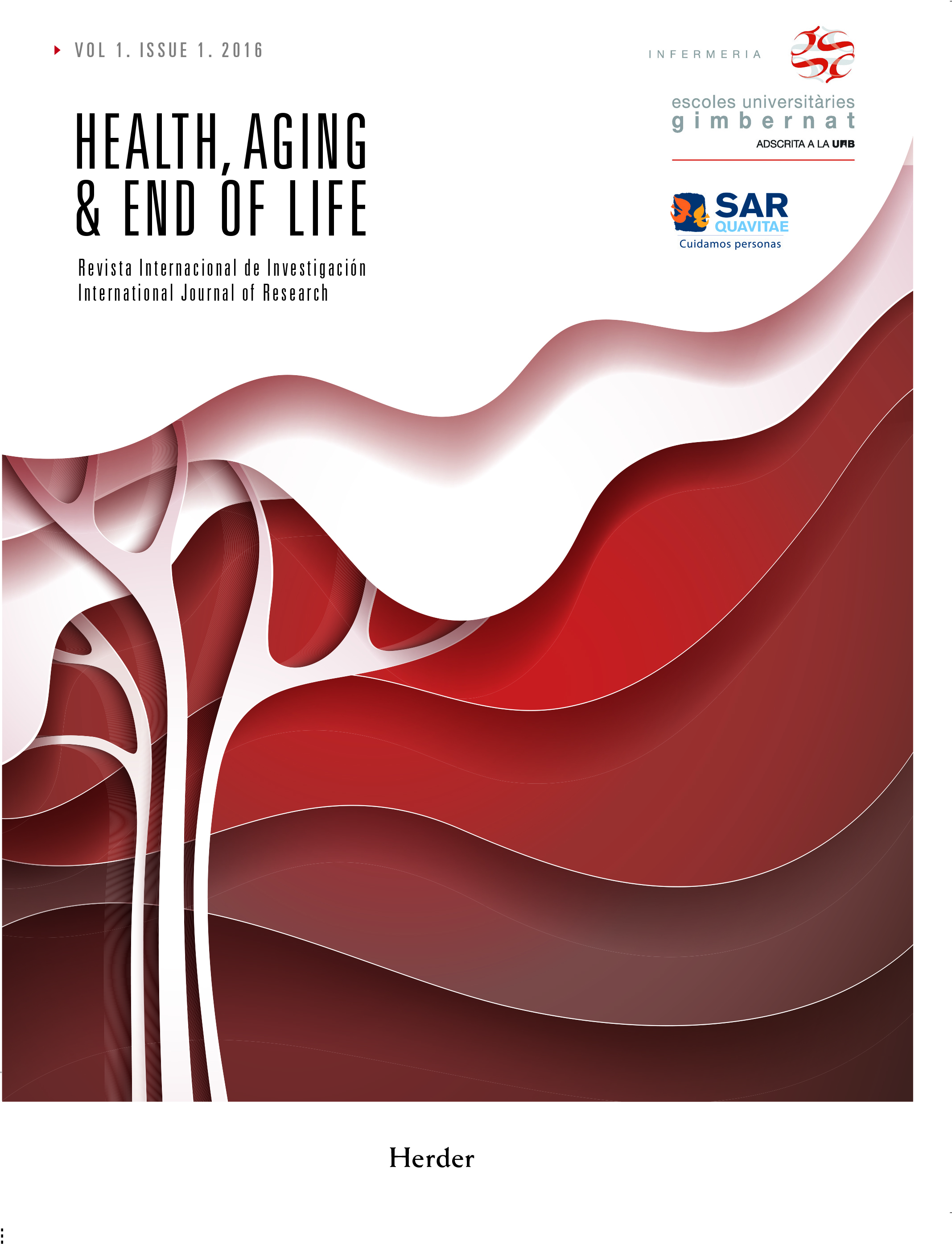Resumen
El objetivo del presente artículo es evidenciar el perfil sanitario de los usuarios atendidos en centros residenciales y sociosanitarios, considerando variables sociodemográficas, clínicas (múltiples patologías, capacidad funcional, deterioro cognitivo, riesgo de úlceras y de caídas) y variables asociadas a la carga de enfermería. Se analizaron los datos de las historias clínicas informatizadas de 3.691
usuarios ingresados durante 2012. Los resultados obtenidos revelan que los centros residenciales se enfrentan a una labor compleja por la elevada multimorbilidad, polifarmacia, dependencia funcional, deterioro cognitivo y necesidades específicas de cuidados sanitarios y sociales de los usuarios atendidos. Los datos expuestos muestran el papel sanitario de los centros residenciales especializados que se configuran como un nivel intermedio de atención cuya labor debería ser acreditada.
Citas
Christensen, K., Doblhammer, G., Rau, R. y Vaupel, J.W. (2009). Ageing populations: The challenges ahead. Lancet, 374:1196-1208.
Cui, Y.L., Wang, T., Wu, X.W. y Chen, D.C. (2013). The use of Charlson weighted index of comorbidities scoring system to evaluate the impact of original diseases for prognosis in intensive care unit patients. Zhonghua Wei Zhong Bing Ji Jiu Yi Xue, 25(2):115-118.
Damián, J., Valderrama-Gama, E., Rodríguez-Artalejo, F. y Martín-Moreno, J.M. (2004). Health and functional status among elderly individuals living in nursing homes in Madrid. Gac Sanit, 18(4):268-274.
Escobar, M.A., Puga, M.D., Martín, M. (2012). Analysis of disability-free life expectancy over the lifespan: from maturity to old age. Gac Sanit, 26:330-335.
Fortin M., Bravo G., Hudon C., Vanasse A. y Lapointe L. (2005). Prevalence of multimorbidity among adults seen in family practice. Ann Fam Med, 3(3): 223-228.
Fundación «Instituto EdadyVida» (2015). Perfil sanitario de las personas ingresadas en centros residenciales. Barcelona: Edad yVida.
Ham, C. (2008). Integrating NHS Care: Lessons from the front line. [Consultado el 22/03/2015]. Disponible en: http://www.nuffieldtrust.org.uk/sites/files/nuffield/publication/integrating-nhs-care-lessons-from-frontline-jan08.pdf
Ministerio de Sanidad y Consumo (2005). Informe Salud y Género. Madrid: Ministerio de Sanidad y Consumo. [Consultado el 08/04/2015]. Disponible en: http://www.msc.es/organizacion/sns/planCalidadSNS/docs/informe2005SaludGenero.pdf
Palomo, L., Rubio, C., Gervas, J. (2006). The comorbidity in primary care. Gac Sanit, 20 (1):182-191.
Quan, H., Sundararajan, V., Halfon, P., Fong, A., Burnand, B., Luthi, J.C., Saunders, L.D., Beck, C.A., Feasby, T.E., Ghali, W.A. (2005). Coding algorithms for defining comorbidities in ICD-9-CM and ICD-10administrative data. Med Care, 43(11):1130-1139.
Ribbe, M.W., Ljunggren, G., Steel, K., Topinková, E., Hawes, C., Ikegami, N., Henrard, J.C., Jónnson, P.V. (1997). Nursing homes in 10 nations: a comparison between countries and settings. Age Ageing, 26 (2):3-12.
Rizza, A., Kaplan, V., Senn, O., Rosemann, T., Bhend, H., y Tandjung, R.; FIRE study group (2012). Age- and gender-related prevalence of multimorbidity in primary care: the Swiss FIRE project. BMC Fam Pract, 13, 113.
Rodríguez, R., Huber, M. y Lamura, G. (Ed.) (2012). Facts and Figures on Healthy Ageing and Long-term Care. Europe and North America.
Vienna: European Centre for Social Welfare Policy and Research. [Consultado el 08/03/2015]. Disponible en: http://www.euro.centre.org/data/LTC_Final.pdf
Rosen, R. y Ham, C. (2008). Atención integrada: enseñanzas de evidencia y experiencia. Informe del Seminario Anual de Salud. Sir Roger Banninster. [Consultado el 22/03/2015]. Disponible en: http://pub.bsalut.net/cgi/viewcontent.cgi?article=1011ycontext=risai
Salive, M.E. (2013). Multimorbidity in Older Adults. Epidemiol Rev, 35:75–83.
Seifarth, J.E., McGowan, C.L. y Milne, K.J. (2012). Sex and life expectancy. Gend Med, 9, 390-401.
Starfield, B., Lemke, K.W., Bernhardt, T., Foldes, S.S., Forrest, C.B. y Weiner, J.P. (2003). Comorbidity: implications for the importance of primary care in ‘case’ management. Ann Fam Med, 1(1):8-14.
van den Akker, M., Buntinx, F., Metsemakers, J.F., Roos, S., Knottnerus, J.A. (1998). Multimorbidity in general practice: prevalence, incidence, and determinants of co-occurring chronic and recurrent diseases. J Clin Epidemiol, 51:367–375.
Vos, H.M., Bor, H.H., Rangelrooij-Minkels, M.J., Schellevis, F.G., Lagro-Janssen, A.L. (2013). Multimorbidity in older women: The negative impact of specific combinations of chronic conditions on self-rated health. Eur J Gen Pract, 19(2):117-122.
Wolff, J.L, Starfield, B. y Anderson, G. (2002). Prevalence, expenditures, and complications of multiple chronic conditions in the elderly. Arch Intern Med, 162:2269-2276.
Zelada Rodríguez, M.A., Gómez-Pavón, J., Sorando Fernández, P., Franco Salinas, A., Mercedes Guzmán, L. y Baztán, J.J. (2012). The interrater reliability of four common comorbidity indexes used in elderly patients. Rev Esp Geriatr Gerontol, 47(2):67-70.

